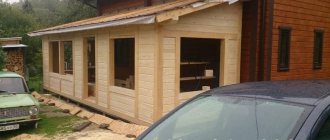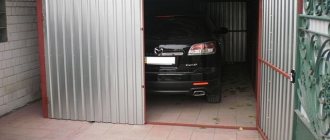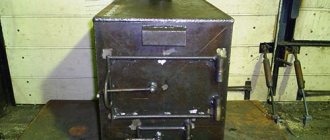MesterulManole
7952 0 1
MesterulManole June 15, 2018Specialization: many years of experience in finishing works of residential and office premises, dachas, country cottages, etc. Hobby: cycling in all its forms
Setting up a living space in the attic is not difficult, the main thing is to choose the right furniture
Built-in wardrobes with sliding doors are a popular solution when arranging apartments. But what about arranging an attic in a country house or in a country house, where, due to the sloping ceiling, an ordinary wardrobe will not fit? It turns out that there are special designs for attics and you will learn about them from this article.
Features of the room
An attic is a room occupying the top floor of a building or part of the attic space. Due to the huge selection of design solutions, the room can have an original configuration. The attic looks especially beautiful in the layout of a wooden house with a sloping roof. The main feature of the attic is the windows: they are small in size, but fill the space well with light.
In addition, the attic extension has many advantages:
- Increase in living space. As a result of competent organization of the space on the second floor, you can get a full-fledged room without spending money that may be needed during new construction and expansion of housing.
- Good thermal insulation of the house. The insulated walls and ceiling of the structure do not allow flows of cold air into the remaining living spaces.
- Aesthetic appearance. The attic floor gives the building a beautiful finished look.
The main disadvantage of this structure is the small height of the room. Glazing a gable roof is expensive, since special types of glass are used for installation. Also, installing high-quality hydro- and thermal insulation is required to equip the attic. When designing an attic space, you need to take into account the fact that most of the structure will be in contact with the street. Therefore, the second floor can be overcooled in winter and overheated in summer.
To avoid this, it is necessary to use SIP panels and special insulation in the decoration of walls and ceilings. In addition, the attic is exposed to external and internal temperature influences. Warm and humid air rises from the living rooms of the house and settles on the interior surfaces of the room.
When designing a room under a roof, several features should be taken into account:
- Correct placement of communication systems. Their layout and installation locations must be provided at the first stage of building construction.
- Shape of the room. The dimensions and geometry of the space directly depend on the design features of the roof.
- Interaction of all engineering systems in the house and attic.
If this room is to be used as a living room, it must have fully functioning electricity, water and heat supply.
Drawings of built-in wardrobes in the attic with different internal contents
Since cabinets truncated to fit the internal shape of the roof slope have a specific design, they are designed strictly for a specific room. It will hardly be possible to rearrange, move or even move such furniture to another room. In fact, even a fully cabinet cabinet in the attic, with side and back walls, bottom and roof, is built-in. Therefore, there is no reason to design such furniture as completely free-standing.
Wardrobes in the attic under the roof slope
The external design of cabinet attic cabinets located along the slope most often looks like this.
The internal content is selected individually for specific needs. A built-in wardrobe in the attic can be equipped with shelves and hangers for clothes, drawers and other mechanisms.
If you need to arrange several sectional modules in a row, we recommend making them on a removable base box. In this case, you can first pull it together and align the “bottoms”, and then place the cabinet bodies themselves on top, on a strictly horizontal level without distortions. Installation and adjustment are greatly simplified.
There are usually no problems with the installation of facades: both hinged doors and sliding compartments can be installed on the buildings.
A special box is designed in the upper part for sliding compartment doors. An external strip can be used to cover the top rail and the gap between the box and the roof, if suddenly it was formed due to inaccuracies in measurement.
How to make a wardrobe in the attic across the roof slope
This option for placing built-in wardrobes in the attic is not uncommon. Here we can distinguish two design options: in the case where the bevel on the cabinets is on one or both sides.
When designing, we take into account personal preferences. The simplest option is to install a regular, “straight” cabinet up to the bevel, and design interesting open shelves on the beveled corner.
photo from newkitchen.eu.com
A built-in wardrobe in the attic can be a single, cast structure completely closed with hinged or sliding doors. In this case, furniture installation is carried out in two stages:
- First, the internal structure of the box is developed, manufactured and installed.
- Based on the installed body of the built-in wardrobe in the attic, the dimensions for the facades are measured. Then they are also manufactured and installed.
This minimizes the risk of error. After all, doors of non-standard shape are significantly more expensive. Especially if these are compartment attic doors with profile frames. An error in calculations can be costly.
The option with hinged facades is easier to implement. Regular furniture hinges with reinforcement are used. Only the door itself has a specific shape.
Sliding roof doors are installed on a special coplanar sliding system. The doors do not “ride” on rails installed in a support type, into the protruding top and bottom of the cabinet. But in fact they “hang”, leaning on the shelves inside the cabinet, the depth of which is calculated for a specific sliding system.
The beginning of the redevelopment of the attic space
Attic floor design ideas look great in photographs, but many homeowners doubt they can achieve the same stunning results. In order not to make mistakes and waste your budget on repairs and redevelopment, you need to act consistently.
With these tips you can create a modern and functional space. It is worth noting that the roof will need additional thermal and waterproofing, which is a significant investment. However, due to this, heat loss in the house will be significantly reduced.
Wardrobe in the attic: a house with a gable roof
In such a house, a good place for a tall wardrobe in the attic is a wall along the ridge. Very often she separates two bedrooms. The door and window system is of utmost importance. If your attic bedroom door is next to a perpendicular wall, you can't put a cabinet on top of it unless it goes right on top of it, which isn't particularly nice. A similar problem applies to windows. If the windows in the upper wall of the house are located too close to the wall, the cabinet placed in it will be exposed to the light of the window. In this situation, a good solution would be built-in wardrobes that open alternately into rooms on both sides.
Bulkhead insulation
Do-it-yourself attic partitions should provide sufficient noise and heat insulation. To provide good protection from sound from other rooms, it is better to install partitions in several layers.
Usually, empty space is left between the layers of the partition, and noise does not penetrate as much. You can also make a combined partition, combining sheets of plasterboard and mineral wool or other soft material that absorbs sound well between them.
Also, to ensure high heat and sound insulation, you can use porous materials for the partition, such as shell rock, gypsum concrete and aerated concrete.
Now let's figure out how to make partitions on the attic floor.
Shell, aerated concrete and brick partitions
Such partitions are quite massive. Therefore, they are installed in large houses where there are concrete and iron floors. Step-by-step instructions on how to make a partition in the attic from brick, aerated concrete or shell rock:
- First, the base is leveled using cement-concrete mortar.
- When constructing load-bearing walls, it is necessary to provide grooves for inserting partitions. If this was not done during the construction stage, then metal rods can be used for fastening.
- Next, a partition is placed, but it should not reach close to the ceiling; there should be a gap between them, which is ensured by inserted wooden wedges. All cracks must be coated with a solution.
- To check the evenness of the installation, use a level.
Shell rock and brick do not require additional protection from moisture, but in aerated concrete a waterproofing layer is installed inside.
Selection of finishing material
The attic is usually built from simple structures. Therefore, its interior decoration requires a special approach and high-quality building materials. As a rule, there is a lot of wood trim inside the attic floor. Therefore, when performing repair work, it is not recommended to use wet processing and give preference to finishing surfaces with dry material.
It is important that the material has several key characteristics:
- Protecting surfaces from high humidity. To do this, the inside of the room is lined with block house or siding, and the floor is laid with laminate. These building materials come in the form of panels and sheets; they are resistant to moisture and do not require additional drying during installation.
- Thermal insulation. Interior decoration involves the use of insulating materials that have a multi-layer structure and significantly increase sound and heat insulation.
- Fire resistance. For dry finishing, choose raw materials with increased fire resistance.
- Light weight. Structures made from hollow partitions are lightweight, which reduces the load on the walls.
For the interior decoration of the attic, natural sheet materials in the form of lining, plasterboard and fiberboard are often chosen. In addition, today there are polymer panels on sale that are no different in quality and appearance from natural wood. To simplify installation, they are equipped with special fasteners. The choice of decorative elements depends on the functional purpose of the room. For the attic, it is recommended to install plasterboard slabs, after which they can be wallpapered or painted. A good option for the attic floor would be to finish the surfaces with plywood or wood panels.
Lining
The most economical and simplest type of attic design is considered to be covering its walls and ceiling with clapboard. This material comes in a variety of colors and allows you to create any style in the room. Sheathing a surface with clapboard will not be difficult: even a novice craftsman can handle it. The disadvantages of the finishing material are its instability to temperature changes and fragility.
But it is absolutely harmless to human health and fits original into the interior of the room, creating an unusual atmosphere of comfort and homely warmth.
Plywood
If the attic renovation needs to be done inexpensively, the right solution would be to line its interior with plywood. Typically, this material is used to level surfaces, but it can also be used as an independent finish. Plywood is durable, lightweight and easy to install. However, it is recommended to install it in rooms with normal levels of temperature and humidity. Therefore, before starting finishing work, you should worry about good thermal insulation of the walls and ceiling. The ceiling or walls covered with plywood can be decorated with textiles or wallpaper. The material coated with paint and varnish looks beautiful.
OSB, MDF, chipboard
Sometimes the layout of the attic floor may include the organization of a work office or home gym in the project. In this case, MDF panels are suitable for finishing the attic. If the room serves as a place for a nursery or bedroom, it is recommended to cover it with OSB boards, which are originally combined with decorative plaster, wallpaper and painting. This will make the interior not boring and cozy. Chipboard would be a good option for decorating an attic. This material is characterized by excellent heat and sound insulation; its installation does not require preliminary leveling of surfaces. It is inexpensive and can imitate the texture of natural stone, brick or wood.
Drywall
Covering surfaces with plasterboard is very popular among craftsmen. This material has high performance properties, which opens up enormous opportunities for design creativity. In addition, under plasterboard structures it is convenient to hide communication systems that can spoil the appearance of the interior. However, this building material quickly absorbs moisture, so it must be treated with a special compound.
The main advantages of drywall include:
- environmental friendliness;
- good noise and heat insulation;
- ease of installation.
When working with this material, you must adhere to special technologies, since the sheets can be deformed.
PVC panels
The finishing of the attic should be done not only with beautiful, but also with durable material. Therefore, PVC panels will be a good choice for decoration. They fasten quickly, withstand various mechanical loads, and create a smooth, even surface. The material is produced in standard white colors and original color shades. PVC panels can be used for finishing walls and ceilings.
They are easy to care for, but are not resistant to ultraviolet rays.
Imitation of timber
An unusual decorative material is false timber. It is a board of small thickness. In terms of quality indicators, the product is in no way inferior to lining. To decorate an attic with imitation timber, no preliminary preparation of the base is needed: the material will independently level the surface and eliminate its defects. Artificial timber looks great in the interior of large and small rooms; you can choose the appropriate texture and color of the material for the design of the room.
Moscow
Artists' town
Verkhnyaya Maslovka
Image: wiki.commons
The architectural complex for artists in the Airport area was built on the initiative of Maxim Gorky and artist Igor Grabar. Designed in the form of a huge “ship of art,” it was supposed to become the center of the Moscow artistic environment, create living conditions for graphic artists, sculptors, and painters. Construction of the complex began in 1929 and lasted about thirty years. In 2008, the town was awarded the status of a cultural heritage site. You can read more about the Artists' Town here. There is a Facebook group dedicated to the complex, where they regularly talk about its history. You can also watch a film from the Russia - Culture TV channel. Or read an article about Maslovka from the old “Creativity” magazine.
high-rise building on the corner of Vavilov and Garibaldi
Vavilova, 65a
Photo: 2Gis
This is what the house looks like from the inside:
View this post on Instagram
A post shared by pourlesenfantsonly (@skajiraz) on Nov 7, 2016 at 1:54am PST
House on Bryanskaya street, 2
Photo: Google Street View
Preparation
The interior decoration of the attic requires proper organization and execution of preparatory work. If the design is done with your own hands, it is necessary to insulate the walls, floor and ceiling, check the chimney pipes and the design of the window slopes. Since the attic is a spacious space with an irregularly shaped roof, when installing double-glazed windows you need to use special models that will harmoniously fit into the design of the room and allow the room to be ventilated. This is important for maintaining constant moisture and temperature inside the building.
Usually the attic space is equipped in houses with a sloping roof , where one slope is made flat and the other steep. Before finishing begins, the attic will have to be given a more functional look, its height raised along the entire perimeter of the building. At the preparation stage, it is important to treat all surfaces of the room with waterproofing solutions and ensure complete sealing of the joints. The base under the floor must be level; it is initially leveled, sound and heat insulation is laid, and then decorative finishing begins. If a bathroom or kitchen is located under the roof, you will have to apply a primer to the surface.
Construction of an attic superstructure
So, if a new house is being built or the roof of the old one does not meet modern operating requirements, then the attic superstructure can be built, as they say, “from scratch.” What does that require. First of all, the project. You can’t just buy building materials and start construction. The attic is not a heavy structure, but this does not mean that it should be treated with less responsibility.
It is better to order the project from professionals who will take into account the load-bearing capacity of the building walls, foundation and other building structures. And on the basis of this, they will create a project that will guarantee that an old or new house with an attic will serve faithfully for decades.
Installation of the attic begins with laying the Mauerlat on the walls of the house. This is a beam with a section of 150x200 or 200x200 mm. It is attached to the walls using anchors that were previously installed in the reinforcing belt. The latter is poured onto the external walls of a private house. How this turns out in the end result is very clearly visible in the photo below.
Mauerlat laid on anchors around the perimeter of a private house Source nauka-i-religia.ru
Attic projects
The first construction operation has been completed. It is carried out regardless of what configuration of the attic was planned by the project. As mentioned above, living quarters can be organized under any roof. For example, the photo below shows an attic under a pitched roof. It would seem that this is not a very successful example, but such projects exist, which means this confirms that it is possible to live under roofs of any configuration.
Attic under a pitched roof Source houzz.se
And yet there is one design that is called attic. It has a broken roof, which cannot be confused with any other.
Classic mansard roof Source favoritst.ru
Checking the roof's readiness
An important point when arranging an attic is to check the attic structure and the condition of the roof, which is often exposed to atmospheric influences and may lose its strength over time. First, determine the degree of wear of the roof and possible options for its repair. To do this, visually inspect all structural parts, their places of fastening and sections. During operation, individual roof elements may become deformed and sag; if such defects are present, they must be eliminated. It is worth paying attention to the reinforced concrete parts of the roof, looking at the degree of their corrosion and wear. All identified damage must be recorded and an action plan must be drawn up to eliminate it.
Since the reliability of the attic’s operation will depend on the strength of the roof, it is important to carefully repair it and further strengthen the structure.
Finishing the attic floor - options
When developing the design of the attic floor of a wooden house, it is permissible to use various types of finishing coatings. The choice depends on the purpose of the attic and the stylistic design. Most often, linoleum, parquet or laminate are chosen for floor finishing. For children's rooms - carpet. Other options are also possible. If the attic will house a kitchen, bathroom or toilet, ceramic tiles are the best option.
When starting to lay the finishing coating, you should properly prepare the base so that no problems arise during the operation of the floor covering. A special underlay is laid under parquet or laminate. It will improve the sound insulation of the attic, adding softness to the floating floor. A cement screed with reinforcing mesh is poured under the tiles.
The appearance and characteristics of the flooring depend on the purpose of the room
Tips and tricks
When designing an attic, it is necessary to determine the size and height of the second floor. The last indicator can be increased or decreased by making appropriate adjustments to the roofing structure.
When laying the roof, you need to take into account that the sound of dripping rain will be clearly audible indoors. Therefore, it is recommended to install the roof from a soft material.
The staircase leading to the second floor should be made of a spiral. This option takes up less space in the garage. It is recommended to make the floor on the first floor concrete. This base has a long service life and can withstand high loads.
If the area of the second floor is small, it is not recommended to sheathe the walls. Instead, the insulation can be covered with inclined shelves. After laying the roof, you should check for holes. To do this, simply hose down the roof and identify leaks.
Design ideas for the attic
Style plays an important role in the visual perception of the room and how comfortable it is to be in it. Interior design should be chosen based on personal preferences and taking into account the functional purpose of the room. It is also important to use various accessories to create a unified style.
A variety of styling options provides many opportunities to create a real masterpiece. The most popular styles of attic rooms are Provence, shabby chic, loft, modern classics, minimalism, modern, Scandinavian and marine styles.
Minimalism in the interior of the attic
Each style has its own characteristics and can play up the specifics of the attic floor. Unplastered brick walls, concrete, and untreated wooden elements will be an excellent basis for an interior in the current loft style.
A mix of brutal materials with a rough structure will become the basis for a discreet and original interior.
The attic can be decorated in different styles. Due to the fact that it is separated from the rest of the rooms, you can choose a design concept that is very different from the rest of the rooms.
Wallpaper
Everything has long been known about the advantages and disadvantages of this material. When finishing an attic, something else is more important - the choice of direction and size of the pattern. After all, the attic differs from all others not only in the sloping attic ceiling, short walls, but also in the lighting - the windows are on the roof, and not in the wall.
- Hue. The smaller and darker the attic, the lighter the wallpaper will be. With the help of a light coating you will not only expand the space, but also add light.
- Material. Paper ones are less durable and beautiful, but are more suitable for unheated attics. Vinyl and non-woven for everyone else.
- Pattern. The size of the print also depends on the dimensions of the attic - the smaller it is, the smaller the pattern you can afford.
To make the interior look harmonious, the attic walls are decorated as follows: the sloping walls are plastered and painted with light, plain paint, and the straight walls are covered with printed wallpaper. If the height of the walls allows, combine the wallpaper with the lining: place the wooden slats at the bottom, and glue the wallpaper above them. This attic design option can be done with your own hands; it looks very stylish and romantic.
Before pasting, first prepare the walls: finishing the attic with plasterboard will solve the problem of an uneven base, but will take away a few centimeters from the area of the room. Plasterboard sheets are suitable for log houses; in slab or brick structures it is better to level the walls with plaster.
WHAT MATERIALS TO USE
The following may be required during the construction process:
- Wooden slats.
- Wooden beams.
- Wooden boards.
- Metal corners.
- Elements for fastening.
- Metal brackets.
- Mineralized wool.
- Waterproofing material.
- Window frame.
- Ladder.
In addition to this list, you will need the basic tools that are used for construction.
Working with floors
The attic ceiling plays a huge role; it acts as a reliable barrier from mechanical stress and sounds. Therefore, the right solution for him would be to lay a floating floor, the design of which will not depend on the strength of the walls and the base of the floor. First, a layer of thermal insulation no more than 40 mm thick is laid on the ceiling and a dry screed is made. The total thickness of the subfloor should not exceed 2.5 cm.
As a dry screed, you can use gypsum fiber boards or sheets of plasterboard. If the surface of the coating has significant unevenness and defects, it must be leveled using vermiculite, expanded clay or perlite. In this case, the material is poured in a small layer of 5 cm.
This produces a good and elastic substrate, the weight of which is usually 25 kg/m2.
Wardrobe in the attic: interiors under a hip roof
Here the wall in which the door is located is often the only one where you can put a cabinet in the attic. The problem is that a wardrobe, although necessary, is not the most important equipment for a bedroom, and for this high part of the room you have to contend with other furniture. In addition, the situation is complicated by pillars and chimneys - it may turn out that the cabinet should be located between the wall and the chimney or build it in such a way that the pillar is in the middle. The effect may be satisfactory, but is certainly more difficult to achieve than inserting a standard piece of furniture.
The cost of finishing the attic
Today, the average attic installation work is assessed as follows:
- impregnation of the frame with antiseptic (2 layers): 80 rubles/sq.m. m;
- antiseptic impregnation of a block house, imitation timber or lining: 120 rubles/sq.m. m;
- frame installation: 120 rubles/sq.m. m;
- installation of heat insulator: 100 rub./sq. m;
- wall covering: clapboard, including plastic - 330 rubles/sq.m. m, block house - 430 rubles/sq. m;
- ceiling covering: clapboard - 400 rubles/sq.m. m, block house - 500 rub./sq. m;
- application of varnish or oil coating: 250 rub./sq.m. m;
- finishing of slopes with clapboard: 550 rub./m. P.;
- installation of plinth and corner: 120 RUR/m. P.;
Total: finishing one square meter of attic will cost 2070 rubles/sq.m. today. m when finishing with clapboard; RUB 2,270/sq. m when finishing with a block house.
Video: do-it-yourself attic finishing
Converting an attic into a cozy attic is available today to homeowners of any income. The main thing is to remember when choosing finishing materials that many of them pose a threat to human health. Give preference only to well-known brands and make purchases in specialized stores, where the likelihood of running into a fake is minimal. It is also important to follow construction technology - if everything is done correctly, the attic will delight the homeowner for many years.
Petersburg
Most of the workshops were found in St. Petersburg. Perhaps because it is a cultural capital; perhaps because there are more readers from St. Petersburg. The houses on Moskovsky Prospekt are especially popular.
House. Department store "Moskovsky"
Moskovsky Avenue, 205 and Moskovsky Avenue, 220
Photo: Galya Voitenko
This house was built in 1963–1965. The leading architect of St. Petersburg in the second half of the twentieth century, Sergei Borisovich Speransky, was the project manager; the house was also designed by architects E. F. Vladimirova, V. V. Isaeva. The Moskovsky department store was located on the ground floor of the house. The last two have large concrete blocks built into them, with spacious workshops behind their large windows. More information about this house can be found in the article on CityWalls, in LiveJournal, in the documentary on Youtube and in the article on Wikipedia.
House of Artists
Pesochnaya embankment, 16
Photo: GradPetra
The House of Artists was built in 1961–1963 by architect A.I. Lapirov. The house belonged to the Leningrad organization of the RSFSR Art Fund. It was understood that artists would live and work here.
In the central part of the house there are 90 workshops with an area of 37–50 square meters and a height of 6 meters. Sculptors worked on the first and second floors, and painters and graphic artists worked on the upper floors. On the sides of the building there are two seven-story wings, containing 56 apartments. More information about the House of Artists can be found here.
Residential building on Petrovskaya embankment
Petrovskaya embankment, 4
Photo: domofoto
This house was built in 1964–1966. Architects - V. F. Belov, A. A. Leiman and A. V. Govorkovsky. Buildings with a neutral facade are distinguished by paintings on tiles on the ground floor, stylized in the spirit of the Peter the Great era. In this house, among other famous artists, lived Georgy Aleksandrovich Tovstonogov, the main director of the Bolshoi Drama Theater, which now bears his name. More about this house in the article on CityWalls.
Houses near the Primorskaya metro station
Korablestroiteley, 23, building 1
This 1969 building housed the workshop of the Lenproekt Institute. The architects tried to solve the problem of the monotony of four long houses, which were supposed to stand one after another on Korablestroiteley Street. They used two types of sections and, for the first time in high-rise construction, used bay windows, which became the main architectural element of the buildings. More information about the series of houses can be found here.
Unedged board
An interesting attic design with wood can be achieved by using unedged boards. This material is obtained by cutting a log lengthwise, but its edges are not processed in any way and remain covered with bark.
For finishing, choose carpentry boards: higher quality raw materials are used in its production. It is perfect for use inside a private home.
How to decorate a small attic?
To design a small attic, use light colors and try to retain as much natural light as possible. If you have only one room, you can zone it with color, contrasting elements or thin partitions. Light transverse beams installed between the roof slopes will help create the illusion of volume.
Wardrobes in a closet
The cabinets can be placed in any attic space where there is enough height for a walkway and reach to the shelves in a vertical position. Most often, the space under the roof slope is reserved for a wardrobe. Clothes can be stored at the bottom of the room.
Therefore, in a minimal wardrobe we only have a separate space in which we have access to open shelves located under the roof slope. We then use low slanted spaces without covering them or building them up (which would be necessary in a bedroom). Instead of ordering custom closed cabinets that fill the space under the slanted walls, we place a wall separating the slanted nooks from the bedroom. However, if we decide to separate the wardrobe, it is best that in addition to the sloped shelves we have space for tall cabinets.
https://www.youtube.com/watch?v=_EiLQYWRajc
DIY attic finishing options: photos of ready-made solutions
If you decide to finish the attic with wood, the best ideas can be used when developing the design of the room. Having decided on the main purpose of the attic, you can begin to develop the design of the project.
Finishing the attic with wood: the best ideas for subsequent implementation
If the space allows, various projects can be implemented. We have collected photos of interesting ideas and invite you to familiarize yourself with them. There are ideas for a large room and design options for a relatively small space.
If you have photos of the decoration inside the attic, share them in the comments. We are interested in what material was preferred and why, how much it cost to furnish the attic space, and when you completed it. Based on this data, our readers will be able to determine the costs of finishing work.
Previous
Wall decorationDecorative plaster: photos in the interior, types, features
Next
Wall finishing Facade plaster for external use - advantages and types of material
MAYBE
Why do they prefer garages with an attic?
The key advantage of garages with an attic floor is the presence of “bonus” living space that can be used at your discretion. In addition to storing cars, such a structure can be used as a dressing room, gym, music studio, kitchen or billiard room. The attic can be used as a playroom for a child, an art studio, temporary storage, a library or a storage room for seasonal items and equipment.
For young families, an extension over a garage can be a good alternative to living with relatives. By arranging a living room above the garage, the newlyweds will solve their pressing housing problem and have the opportunity to create a cozy family nest.
The project of a garage with a residential attic is also attractive because the construction of such a facility will not cost much more than a standard garage, while the construction of a separate structure requires additional space and financial investments.
A garage with an attic is a way to save on land area and finances Source assz.ru
See also: Catalog of garage projects presented at the Low-Rise Country exhibition.
Ceiling lining
The most popular way to decorate the ceiling in an attic interior is to decorate it with clapboard. If the design project involves the use of wood in the attic, it is recommended to first cover the ceiling surface with sheets of plasterboard, and then proceed with the finishing cladding. Wooden decor allows the use of various types of lining. To give it aesthetics, you can paint the boards in light or dark shades. To prevent the attic interior from becoming boring, a combined finish consisting of wooden inserts and hanging structures that need to be framed with molding is suitable for the ceiling.
An interesting solution for the ceiling would be cladding with decorative stone: it will help revive the overall decor of the room and make the room unusual.
Expanded polystyrene (PENOPLEX)
Expanded polystyrene is an improved and more expensive version of polystyrene foam. This material is characterized by high strength and moisture resistance. Typically, in construction stores, polystyrene foam is offered in the form of slabs with grooves for tight joining, which allows you to create light thermal insulation without gaps. Like polystyrene foam, penoplex is a flammable material that emits dangerous toxic compounds when burned.
SAWDUST
Sometimes, when insulating yourself, they use the “old-fashioned” method - sawdust. This is an environmentally friendly and very cheap material - sometimes you can get it absolutely free. However, sawdust is susceptible to getting wet and rotting. In addition, they are highly flammable and are a favorite habitat for rodents. If you use a sawdust-cement mixture rather than pure sawdust as insulation, many disadvantages can be avoided - such insulation does not burn, does not rot, and does not attract mice and insects. However, the sawdust-cement mixture is heavy enough to be used to insulate an attic space in a wooden house, and can overload the supporting structure and floors.
Ideas and design options
One of the disadvantages of an attic with a staircase in a country house is its small area, so arranging the rooms often becomes a problem. But the interior of a limited space can be decorated in an original way using various design tricks. A beautiful ceiling shape and the right choice of color will help visually expand the space and make the room cozy.
The design idea looks unusual, in which the attic is completely decorated with wood; its painting can be done with a special varnish. Such a room is suitable for organizing a bedroom; it can become a relaxation area. Wooden decor will become an integral part of a house made of timber. The attic space, lined with light-colored boards, looks beautiful. It hides strict lines, making the room seem light.
For a small attic, it is better to choose a combined finish, in which the stairs and partitions will be made of wood, and the walls will be covered with decorative plaster or covered with white wallpaper.
To learn how to arrange an attic, see the following video.
Cabinet lighting: beautiful and practical
Very often, despite a sufficient number of windows and artificial light sources, attic closets and dressing rooms are equipped with an additional lighting system. Such a technical addition solves two problems at once: aesthetic and utilitarian - it’s convenient when there is an illuminated area in front of the mirror, and it’s easier to look for the right things in the light. Lamps are installed in a mortise or overhead manner; Depending on the type of lamps used, there are halogen, LED and fluorescent lamps, as well as LED strip.
Lighting in the dressing room Source pinterest.fr
LED lamps are increasingly used when designing cabinets; They are attractive due to their efficiency, long service life and operational safety. The spectrum that closely matches natural light makes them convenient for use in both external and internal lighting. Lamps with LED elements can be found in the canopy of the dressing room and in the internal sections, where their combination with a motion sensor would be practical. Such an automatic system will save you from having to turn on the light when opening the door and remembering about it when closing it.
Maximum use of space Source pinterest.com











